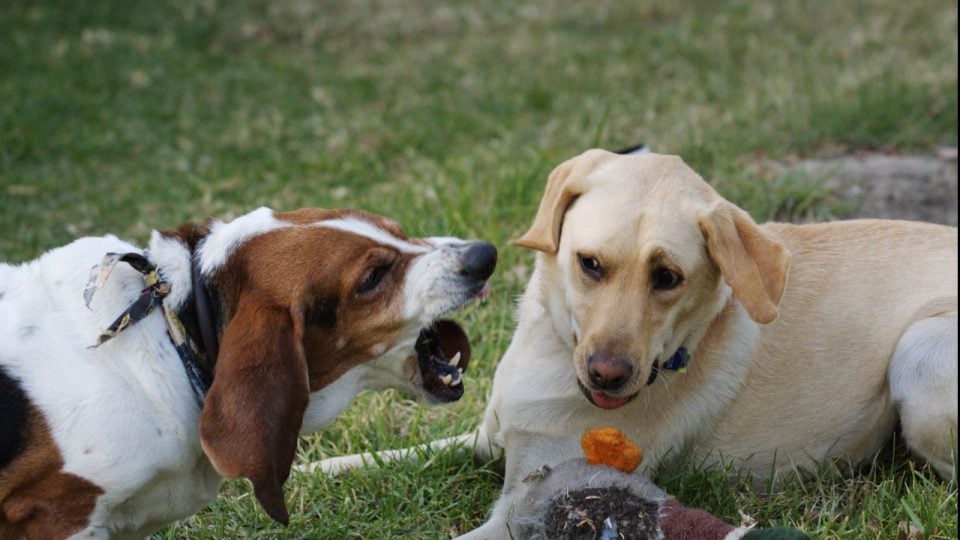Even though most of us strongly feel that our dogs are members of the family, the truth is that, no matter how much we want them to be, pets are not human. And that truth can sometimes hurt (literally!), especially when it comes to resource guarding.
What Is Resource Guarding In Dogs?
Resource guarding is a dog’s tendency to protect objects, locations and sometimes people, from competitors. In the animal world, this is a natural, deep-seated reaction to a threat. A dog who guards their most precious things and safest spaces is more likely to be a dog that is successful at surviving and reproducing.
But in a domestic environment where we provide our dogs with an endless supply of food, toys, tasty treats and comfortable places to bed down, resource guarding is not just a useless behaviour but a dangerous one.
Unfortunately, though, your dog’s resource guarding isn’t based on logic, it’s a genetic drive deep inside a dog’s DNA. A dog that guards isn’t ‘dominant’ or ‘alpha’, they are just acting in ways they were genetically programmed to act.
Luckily, resource guarding doesn’t have to be a lifetime sentence that will have you and your family tiptoeing around your dog for years to come. We can teach a resource guarding dog how to share and our simple guide will help them get there.
-
Pixabay/AdinaVoicu
What Kind Of Resources Do Dogs Guard?
Dogs can guard anything that has value to them including:
- Food bowls or puzzle toys
- Food items ‘discovered’ on a counter or table or on the ground outside
- Chews like bully sticks and pigs ears
- Beds, couches or other comfy spaces
- Toys and balls
- Random objects, especially anything that you seem eager to retrieve from them
- Family members
What Does Resource Guarding Look Like?
Not every dog growls when they guard but this sound, along with a handful of body language cues and actions, seen when you are approaching your dog as they eat, sleep or play are common indications that your dog is not willing to share:
- Freezing up (the body suddenly goes stiff while the eyes shift into a ‘hard’ stare into the middle distance)
- Eating faster
- Growling
- Snarling (curling the top lip to show the teeth)
- Air-snapping (a pseudo-bite not intended to make contact)
- Bite
How Can We Teach A Dog To Share?
To overcome resource guarding, we use a process of desensitisation and counter-conditioning. These methods gradually decrease a dog’s desire to guard over time by systematically exposing them to a trigger (beginning with steps that are small and non-threatening) while simultaneously changing the dog’s emotional opinion about the perceived threat.
Desensitisation and counter-conditioning can be tricky. If you need help, look for a certified positive-reinforcement trainer or veterinary behaviourist that can guide you through the process. Anyone with a dog who has a history of biting when guarding should consult with an expert before beginning training.

Pixabay
Training A Dog To Share A Food Bowl Or Puzzle Toy
It will take time to teach your dog to share and it’s important to have a plan from day one. Repetition is essential for this kind of training.
Try setting aside 30 minutes a day to do 25 repetitions of a single step. Stick with that step until your dog shows obvious signs that they are pleased to see you approach (see below).
- Approach an empty food bowl/puzzle toy from at least six feet away. Drop extra special, high-value treats in the bowl then walk away. In some of your later repetitions, touch or pick up the bowl, then drop treats inside and walk away.
- Approach a food bowl filled with dry kibble from at least six feet away. Drop extra special, high-value treats in the bowl then walk away. In some of your later repetitions, touch or pick up the bowl, then drop treats inside and walk away.
- Approach a food bowl filled with half kibble, and half canned food from at least six feet away. Drop extra special, high-value treats in the bowl then walk away. In some of your later repetitions, touch or pick up the bowl, then drop treats inside and walk away.
- Approach a food bowl filled with canned food from at least six feet away. Drop extra special, high-value treats in the bowl then walk away. In some of your later repetitions, touch or pick up the bowl, then drop treats inside and walk away.
- Approach a food bowl filled with dog-friendly human food like chicken from at least six feet away. Drop extra special, high-value treats in the bowl then walk away. In some of your later repetitions, touch or pick up the bowl, then drop treats inside and walk away.
Training A Dog To Share A Bed Or Couch
As above, try setting aside 30 minutes a day to do 25 repetitions of a single step. Stick with a step until your dog shows obvious signs that they are pleased to see you approach (see below).
- Pick a piece of furniture your dog doesn’t typically guard and ask them to jump up on it. Immediately ask them to get off the furniture then reward them with an extra special, high-value treat. Repeat.
- Generalise step one by asking your dog to get up on other pieces of furniture that your dog doesn’t typically guard. Ask them to immediately get back off the couch then reward them with an extra special, high-value treat. Repeat.
- Move to a location your dog has guarded in the past. Ask them to get on the furniture and then to immediately get off again, rewarding once they are on the ground. Repeat.
- Begin asking your dog to get off of the furniture outside of training sessions. Reward heavily when they respond.
How Do You Know When To Move To The Next Step?
To move at a speed that will actually change your dog’s behaviour, you must look to them to tell you when they’re ready to progress in their training. If you have correctly counter-conditioned your dog to allow you to approach their food bowl, for example, they will be pleased when you do instead of becoming tense and upset.
Keep Generalising
Once you’ve begun teaching your dog to share, they are unlikely to have the same improved reaction to the approach of other family members when eating or sleeping as they do with you. This is because dogs are not very good at understanding that one rule applies to multiple contexts.
To get around this, make sure that multiple people in the household practise resource guarding training with your dog. That includes family members and also friends and any pet sitter or dog walker your dog spends time with.
Dog training guru Jean Donaldson recommends that a dog goes through training with three or four people (preferably of different ages and genders) before they can be considered reliably ‘cured’ of their guarding issues.
However, even once this has been accomplished, putting your dog in the position of being approached by a stranger when eating or sleeping will always be a risk. This should be avoided at all costs. Set your dog up for success with training and management, and you’ll both be happier.




